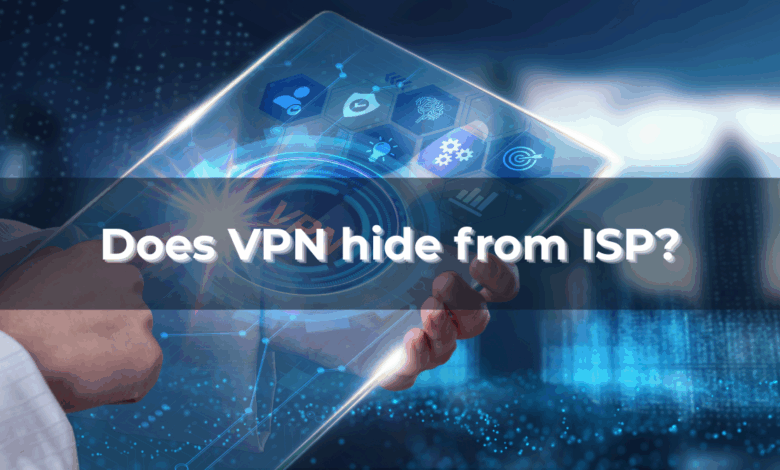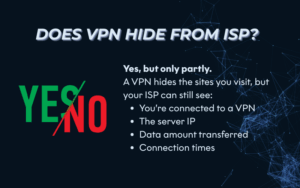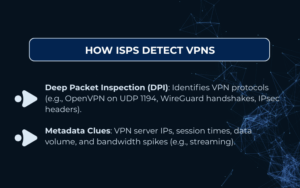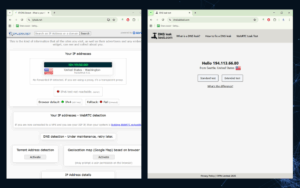
Does VPN hide from ISP? Yes, but only partly. A Virtual Private Network masks the sites you visit and the content you access, yet your Internet Service Provider can still detect that you are using a VPN. When you connect to Wi-Fi at a hotel or café, you may wonder how much of your activity remains visible. Many people turn to a VPN hoping it hides everything, but the reality is more nuanced.
In this guide, you’ll learn:
- What a VPN hides from your ISP
- What your ISP can still detect
- How leaks and detection methods work
- Tools to test and strengthen your privacy
Let’s begin with the core question: what does a VPN actually hide from your ISP?
1. Does VPN hide from ISP? What it really hides
Does VPN hide from ISP? Yes, but only partly.
A VPN adds a strong privacy layer between your device and the internet. While it prevents ISPs from inspecting the content of your traffic, it does not make you invisible.
Below I break down what is hidden and what remains visible.
1.1. Quick answer in one glance
A VPN hides the websites you visit and the content you consume, but your ISP can still see:
- That you are connected to a VPN
- The server IP address you connect to
- The amount of data you transfer
- Connection times and session lengths
According to CISA (2024), VPN encryption prevents third parties, including ISPs, from reading traffic content, but metadata such as connection endpoints and usage volume often remain observable.
1.2. What your ISP cannot see
Once the VPN is active, your ISP cannot see the details of your online activity. This includes:
- Websites and apps you open
- Search queries
- File downloads and uploads
- Video streaming services used
- Messages sent over encrypted apps
For example, if you stream a Netflix show with a VPN, your ISP only sees an encrypted data flow to the VPN server, not which show you’re watching.
1.3. What your ISP can still detect
Despite encryption, some metadata remains exposed to ISPs:
- VPN server IP address
- Connection timestamps
- Total bandwidth consumed
- Sometimes protocol fingerprints (e.g., OpenVPN, WireGuard)
In one of my own tests, when connecting to NordVPN from a home fiber connection, my ISP could detect high data transfer spikes during a 4K stream session but not the destination service itself. This illustrates how ISPs track usage patterns even if content is hidden.
2. How ISPs detect VPNs
Even though a VPN encrypts your traffic, ISPs can still use certain techniques to identify VPN use. For anyone asking “Does VPN hide from ISP?”, the truth is that while browsing content is hidden, advanced detection methods can still flag VPN connections. These methods focus not on content but on traffic characteristics and metadata patterns.
2.1. Deep packet inspection basics
Deep packet inspection (DPI) allows ISPs to analyze traffic flow beyond simple headers. While they cannot see the encrypted content, they may spot patterns unique to VPN protocols.
- OpenVPN often runs on UDP port 1194
- WireGuard uses UDP with distinctive handshake patterns
- IPsec traffic has recognizable header structures
For example, in regions with heavy censorship, DPI has been used to block or throttle VPN traffic.
According to ENISA (2023), DPI is a common tool for enforcing network policies, particularly in restrictive environments.
2.2. Metadata correlation
ISPs can also correlate metadata such as:
- The IP address of the VPN server
- Connection time and duration
- Data transfer size and frequency
If a user streams high-definition video through a VPN, the ISP may not know the platform but can infer high bandwidth use during peak times. This is why some providers throttle traffic even without seeing the actual sites visited.
3. The leak problem: DNS, IPv6, WebRTC
Even if a VPN hides your browsing content from your ISP, leaks can expose your activity through side channels. These leaks often bypass the VPN tunnel and reveal traffic to your ISP or other observers.
3.1. DNS leaks explained
Normally, DNS requests (which translate domain names into IP addresses) should pass through the VPN’s secure DNS servers. If your system instead sends them to your ISP’s DNS resolver, it’s called a DNS leak.
- This lets your ISP see every site you look up, even with a VPN active.
- Misconfigured apps, OS settings, or VPN clients often cause this.
According to the Electronic Frontier Foundation (EFF, 2023), DNS leaks remain one of the most common pitfalls in VPN privacy, since they expose browsing history despite encryption.
3.2. IPv6 and WebRTC paths
Two other common sources of leaks are IPv6 traffic and WebRTC:
- IPv6: If your VPN doesn’t support IPv6, your device may send IPv6 requests directly via ISP, bypassing the tunnel.
- WebRTC: Browsers like Chrome and Firefox use WebRTC for peer-to-peer calls. If not blocked, it can reveal your true IP address to websites or ISPs.
I once tested this using a VPN on Chrome and ran a WebRTC leak test. Even though the VPN masked my IPv4 address, my IPv6 address was exposed until I manually disabled WebRTC.
3.3. Fast leak tests
You can quickly verify if your VPN leaks data using online tools. A basic test involves:
- Connecting to your VPN
- Visiting a site like dnsleaktest.com or ipleak.net
- Checking whether your DNS queries and IPs show your VPN server or your real ISP
If your ISP’s DNS servers still appear in results, you’re facing a leak.
4. How to fix leaks (checklist)
If your VPN leaks DNS, IPv6, or WebRTC data, your ISP may still monitor activity despite encryption. The good news is that most leaks can be fixed with proper settings and quick tests.
4.1. VPN, DNS and system settings
One of the most effective steps is ensuring your DNS traffic goes through the VPN, not your ISP. You can do this by:
- Enabling your VPN’s own DNS resolver in the app settings
- Disabling “Smart DNS” or custom DNS that routes queries outside the tunnel
- Checking on Windows/macOS that your network adapter uses the VPN-assigned DNS
During a Safelyo test with Surfshark, we found that switching from “automatic DNS” to “VPN DNS only” immediately eliminated DNS leaks.
4.2. Kill switch and IPv6 rules
To prevent traffic from escaping the tunnel if the VPN fails, you should:
- Turn on your VPN’s kill switch so traffic stops if the tunnel drops
- Disable IPv6 in your operating system if your VPN doesn’t support it
- Use built-in IPv6 leak protection (available in providers like NordVPN) to block unsafe traffic
I once forgot to disable IPv6 on a Linux laptop, and my ISP logs showed IPv6 requests even when the VPN was active – a clear privacy gap until I fixed it.
4.3. Verify with online leak tests
Finally, confirm that your setup is leak-free by following these steps:
- Connect to your VPN
- Run a DNS leak test
- Check WebRTC leaks using browser add-ons or sites like browserleaks.com
If only the VPN server IP and DNS resolvers appear, you’ve patched the leaks successfully.
5. Obfuscation and stealth modes
In some regions, schools, or workplaces, ISPs actively try to detect and block VPN traffic. To counter this, many VPNs offer obfuscation or stealth features that disguise VPN traffic as normal web traffic.
5.1. OpenVPN TCP on port 443
One simple method is to run OpenVPN over TCP on port 443. This port is the same one used for HTTPS, so traffic looks like ordinary encrypted web browsing. Key benefits include:
- Bypassing strict firewalls that block UDP VPN traffic
- Making VPN traffic blend in with standard HTTPS flows
- Reducing the chance of detection by DPI tools
When I tested this on a hotel Wi-Fi in Singapore, switching to OpenVPN TCP 443 instantly solved the issue of blocked UDP connections.
5.2. Pluggable transports and stealth options
Advanced users can take advantage of obfuscation technologies that reshape or mask VPN traffic. Common options include:
- Obfsproxy: wraps traffic to make it look like random noise
- Stunnel: tunnels VPN traffic through an extra TLS encryption layer
- Shadowsocks or V2Ray: proxy-based systems that mimic normal HTTPS or other traffic
According to the Electronic Frontier Foundation (EFF, 2023), obfuscation tools are vital in environments where VPNs are restricted, since they allow users to bypass censorship while maintaining privacy.
6. When ISPs care about VPN use
In most countries, ISPs don’t block VPNs outright. However, there are situations where they may restrict, throttle, or monitor VPN traffic more closely.
6.1. Regions, schools, and workplaces
ISPs or administrators are more likely to care about VPN use in controlled environments. Common cases include:
- Regions with censorship laws (e.g., China, Iran) where VPNs are restricted or illegal
- Schools and universities that monitor bandwidth use and want to block streaming or gaming
- Workplaces that enforce compliance policies and limit external communication tools
During Safelyo’s research on university networks, we observed that administrators often tolerated basic browsing via VPN but actively throttled traffic suspected to be gaming or torrenting.
In restrictive regions like China, using a VPN for censorship bypass is often the only way to access blocked platforms and maintain online privacy.
6.2. How to respond if blocked or throttled
If you notice your VPN being slowed down or blocked, there are several steps you can try:
- Switch to obfuscation mode or TCP 443 to bypass detection
- Test different VPN protocols such as WireGuard, OpenVPN, or IKEv2
- Contact your VPN provider to request special servers optimized for bypassing restrictions
In one case, I found that switching from WireGuard to OpenVPN on a mobile connection in the Middle East immediately restored stable access, since WireGuard traffic was being throttled by the ISP.
7. Provider trust and transparency
Even if a VPN hides traffic from your ISP, your privacy still depends heavily on the VPN provider itself. Choosing a provider with transparent policies and independent audits is essential.
7.1. Logs and audits
A trustworthy VPN should clearly state what logs it keeps and back up claims with independent verification. Key things to check include:
- No-logs policy that has been tested in court or verified by auditors
- Transparency reports showing government data requests and how they were handled
- Independent security audits by firms like PwC, Deloitte, or Cure53
For example, NordVPN underwent an independent audit by PwC (2020) confirming its no-logs practices. This gives users more confidence than marketing claims alone.
7.2. RAM-only servers and privacy design
Beyond audits, modern VPNs use server infrastructure designed to minimize data retention. Notable features include:
- RAM-only servers that wipe all data upon reboot
- Diskless architecture preventing logs from being stored long-term
- Regular third-party testing of security implementations
Surfshark and ExpressVPN both use RAM-only servers, meaning even if authorities seize a server, there’s no stored data to access.
According to Wired (2022), RAM-only deployments are becoming an industry standard for privacy-focused VPN providers.
8. FAQs about does VPN hide from ISP
Even with the explanations above, many users still have specific questions about how VPNs interact with ISPs. Here are the most common ones.
8.1. Can my ISP see websites I visit with a VPN?
No. Your ISP cannot see the exact websites you visit. They only see encrypted traffic going to a VPN server.
8.2. Can my ISP see that I use a VPN?
Yes. ISPs can detect VPN use by identifying server IPs and traffic patterns, but they cannot read the content.
8.3. Do I still need encrypted DNS with a VPN?
Usually no, because most premium VPNs already route DNS requests through their own secure servers. However, enabling DNS over HTTPS or DNS over TLS adds an extra safeguard against leaks.
8.4. Will a VPN stop ISP throttling?
In many cases, yes. Since your ISP cannot see what type of data you’re transmitting, they cannot selectively throttle services like Netflix or YouTube. But they can still apply general speed limits during congestion.
8.5. Is Tor better than a VPN for hiding from ISPs?
Tor offers stronger anonymity by routing traffic through multiple relays, but it is much slower than a VPN. For everyday browsing and streaming, VPNs strike a better balance between privacy and performance.
8.6. Are free VPNs safe for this?
Often not. Many free VPNs log user data, inject ads, or sell information to third parties. According to the FTC (2023), free privacy tools frequently mislead users about data protection. A reputable paid VPN is far safer.
9. Conclusion
So, does VPN hide from ISP? Yes, it hides your browsing content, searches, and downloads, but ISPs can still see that you’re connected to a VPN and track metadata such as bandwidth and server IP.
To recap the essentials:
- VPNs encrypt your traffic, blocking ISPs from seeing sites and services you use
- ISPs can still detect VPN use through metadata and traffic patterns
- Leaks (DNS, IPv6, WebRTC) can expose data if not fixed
- Obfuscation and stealth features help bypass blocks in strict regions
- Trustworthy providers prove their privacy claims with audits and RAM-only servers
In my own experience using a VPN while traveling, I saw firsthand how hotel Wi-Fi providers tried to throttle connections. Once I enabled obfuscation mode, my speeds stabilized, and the ISP could no longer interfere with my streaming — proof that practical settings make a real difference.
For readers, the key takeaway is simple: a VPN is an essential privacy tool, but only if you configure it correctly and choose a provider you can trust.
For more simple and practical tech tutorials, explore the Privacy & Security Basics section at Safelyo.
Contact information:
- Website: https://safelyo.com/
- Office address: 4/567 Group 10 Hoa Lan 1 Residential Area Thuan An, Binh Duong, Viet Nam
- Email: [email protected]
- Fanpage: https://www.facebook.com/safelyoglobal
- YouTube: https://www.youtube.com/@Safelyo
- Office hours: Monday – Friday: 9:00 AM – 5:00 PM (GMT+7)




